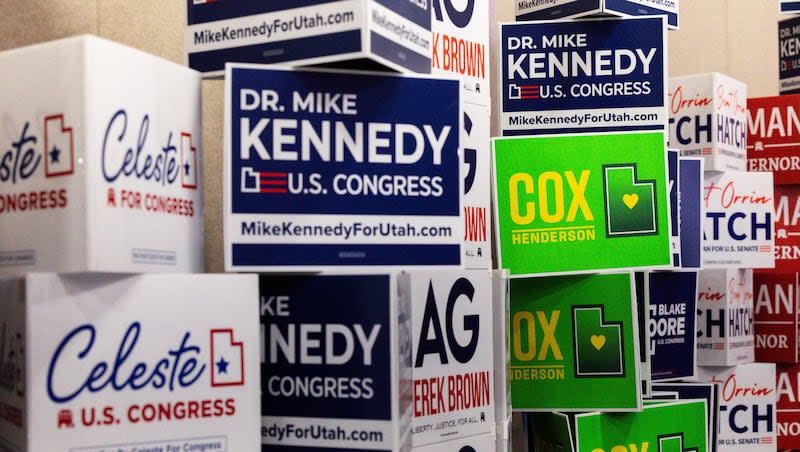Opinion: Should Utah adopt a runoff system for crowded primaries?

Now that we’re starting to get past all the talk about the raucous and nasty state GOP convention last weekend, it’s time to come face-to-face with an uncomfortable political reality.
Utah still has no way to ensure that a multi-candidate primary results in anyone coming near a 50%-plus-one vote majority, and it’s about to decide three major Republican races with the real chance that the winner emerges with a small plurality.
The Senate seat Mitt Romney is vacating has four candidates, and the Third District congressional seat John Curtis is vacating has five. The race for state attorney general has three GOP candidates.
Ever since state lawmakers allowed a two-pronged route to the ballot — one through the traditional caucus/convention system and the other through signature-gathering — crowded primaries have become a real possibility.
In 2020, Spencer Cox became the Republican nominee for governor with only 36.4% of the vote in a four-way race. He went on to win the general election. Utah’s First District congressman, Blake Moore, won his four-way primary in 2020 with a little more than 30%. This time around, the party nominee for Senate, and presumptive eventual winner, might need only somewhere in the mid-20th percentile of votes to prevail. The Third District congressional representative might need less.
As I asked readers four years ago, is it enough to simply say that democracy is messy and move on?
The answer, I’ve come to believe, is yes.
That’s not a happy yes, mind you, but it is an educated yes. The alternatives aren’t likely to lead to any better outcomes.
In eight states, the law requires primary election winners to have at least one more than 50% of the votes, according to the National Conference of State Legislatures. In two other states, they are required to reach a lesser threshold — in North Carolina, a second-place finisher can request a runoff, but only if the winner got less than 30% of the vote. In South Dakota, a runoff among the top two finishers is triggered if no candidate exceeds 35% of the vote.
The downside to this is that a runoff election would not represent a simple redo of the first election, only with just two candidates. Critics note that these second elections almost always have a lower turnout than the first ones. In other words, a different subset of voters is making the selection.
Even the highly publicized 2022 runoff in Georgia between Democratic Sen. Raphael G. Warnock and Republican Herschel Walker resulted in 400,000 fewer votes cast than the general election.
People who decide not to vote can have an effect on any election. So can weather and several other factors. Utah still conducts elections largely via mail-in ballots, but a primary election runoff, especially during the summer vacation season (this year’s primary will be June 25), might also lead to a lower turnout. Each election relies on decisions by those who care enough to show up. But no two elections are exactly alike.
The other option is for the state to conduct primaries using ranked-choice voting, otherwise known as an instant runoff. Utah currently is running a pilot program for cities and towns that wish to use this method. Results have been mixed, but Republican state lawmakers nearly killed the program earlier this year not long after former president Donald Trump came out against it.
With ranked-choice voting, people may rank each candidate in order of preference. As votes are tallied, last-place finishers are eliminated, and the second choices on their ballots distributed, until someone reaches a true majority.
This provides a semblance of a redo without calling for an expensive new election, but this method is unlikely to see a future in Utah. Its results likely would stoke conspiracists, who don’t need much evidence these days. That would be especially true if someone were to win on the strength of second-place votes.
The state could adopt so-called “jungle primaries,” in which candidates from all parties compete. If no one receives a majority of votes, the top two compete in a runoff, even if they both belong to the same party. But this is unlikely to appeal to Utah lawmakers, especially with the Republican Party dominating most races.
As I have said before, there is no perfect way to handle multiple-candidate elections. And yes, attracting several candidates to a primary ballot is a sign of a healthy democracy.
For reference, popular former Gov. Mike Leavitt won a three-way race in 1992 with just 42.2% of the vote. And numerous presidents, including Trump, have won with less than half the popular vote.
The question is how many candidates Utahns will tolerate for a single office in a primary election before they begin to question the legitimacy of the winner. Perhaps the answer is something greater than five.

